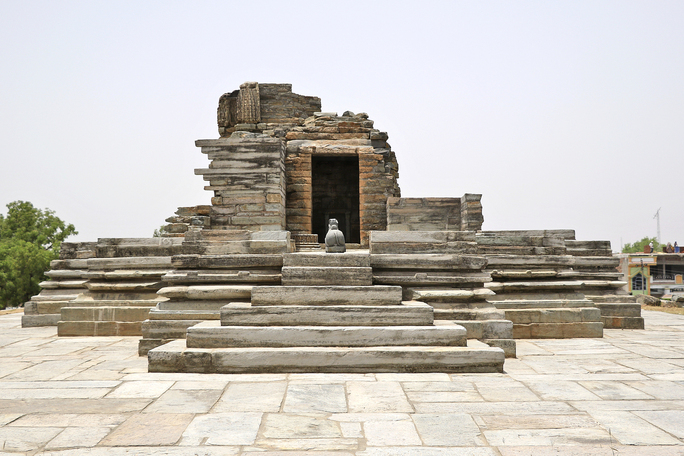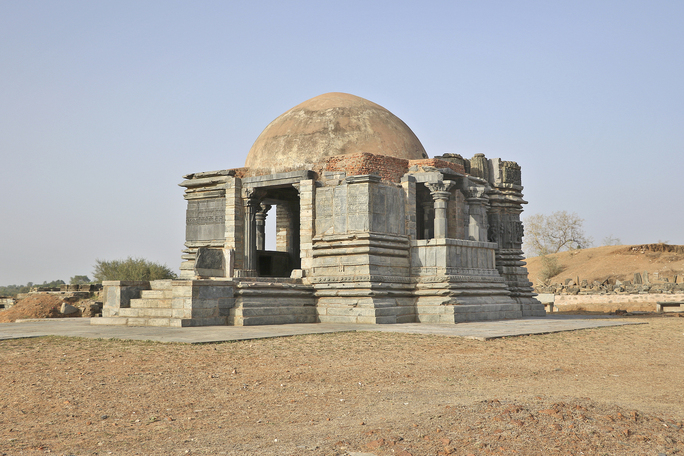
The old name of the Arthuna was Utthunaka. It was the capital of Paramara rules of Vagada during eleventh-twelfth centuries CE. They patronized both Jainism and Saivism simultaneously, so they constructed a number of temples. An inscription of the Paramara prince Chamundaraja records that he built a temple of Siva called Mandalesa in honour of his father in V.S. 1023 ( 1079 CE). Another inscription of V.S. 1022 ( 1080 CE) mentions that his officer's son named Anantapala also founded a temple of shiva. In a group of temples known as Hanumangarhi are located there with Neelkantha Mahadeva temple, other miniature shrines and a stepped kunda. The place was associated with the Lakulisa sect of saivism. The temple of Hanuman and Vishnu also belong to the early period. Besides, there is also a jaina temple built by Bhushana in VS 1133 ( 1190 CE) and temples dedicated to chausatha yoginis & Shiva. The Mandalesvar Shiva temple is located near the Bus stand of Arthuna . It majestically stands on a platform (Jagati) facing east and is Saptayatana in construction. It seems that there were six small temples surrounding the main shrine, of which some temples have now been demolished and their remains are only visible. The Garbhgriha exhibits projections of Bhadra, Nandika, Pratiratha, Karna, Kapota and others. A rectangular Antarala connects the Sabhamandapa with Garbhgriha. A Mukhamandapa existed in front of Sabhamandapa which is approached through a flight of steps. In the Nandimandapa, the installation of Nandi images was done.
The Mula prasada has Bhittas, Cyma-reersa (Jadyambha), Kani-Antarapatra, several mouldings of Kapota and Grassa patti. A makarmukha pranala pierced out in the northern side of the plinth. The lower part of the Janga is plain but the upper portion is profusely decorated with vertical fillets of lotus creeper designs and others. In the principal Bhadra niches of Mandovar, an eight armed Shiva, an eight armed Natesha and an eight armed Chamunda existed. The Sikhara has three empty Rathikas in north, west and south directions.
The square Garbhagriha enshrines a big Yonipatta but the Shiva linga is missing. A loose figurine of Parvati is there, seated on a two tiered pedestal holding Trishula, Khatvanga, Bijapuraka and Varada attributes. The icon being little larger than the Bhadra niche of the sanctum seemed to have been replaced there at some later date. The ceiling of the sanctum consists of receding course of Karnatardarika carved with lion frieze. The Padmasila is in the centre, while the four broadly carved lion heads (kirtimukhas) appear at the corner. It is classified as Kshipta-Vitan. The moulded door sill (Udambara) exhibits a semi circular Mandaraka with stalked lotus scrolls and Hamsas, flanked by Kirti-Vaktras on either side.
The door frame is beautified by 5 vertical sections named vegetal scrolls (patra sakha) , Rupa Stambha, Gandhara Sakha and others. The Rupa stambha section contains the Ghatta- Pallava on the top and is depicted with the figuriness of Brahma, Vishnu and Shiva, each accompanied by a maid attendant. The lower portions have the figures of Ganga and Yamuna having their Vahans Makar and Kurma. The inside niches have several sculpturess. The Uttarang Patta displays Brahma, Vishnu and Lakshmi inside the small niches.
The vestibule (Antarala)'s ceiling is of Samatal variety, carved with four fully blown medallions. The Sabha-Mandapa is open on lateral sides and rested on gate and other pillars. Ceiling is exquisitely carved and could be placed at par with Mandalesvar temple of Panaheda.








